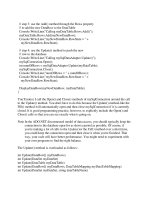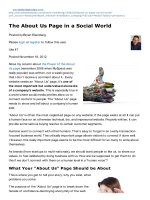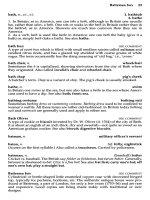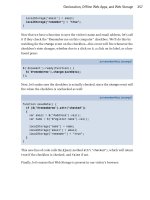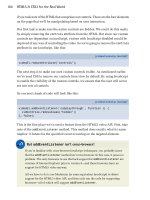wiley philanthropy in a flat world phần 2 doc
Bạn đang xem bản rút gọn của tài liệu. Xem và tải ngay bản đầy đủ của tài liệu tại đây (105.1 KB, 23 trang )
7
Chapter One
The Flat World
From Columbus to Skinny Lattes
B
efore Christopher Columbus, Vasco da Gama, and
others took up the challenge of the unknown and sailed
out into the wide oceans to look for and conquer new
lands, we believed the world was fl at. We could see until
a certain point, and then the land and ocean started to
disappear.
Then our explorer friends, helped, incidentally, by
Galileo and astronomers everywhere, allowed us to realize
that actually our planet was round. It was spinning through
FLAT AND BEAUTIFUL
8
a universe of other stars and planets, all of which seemed to
be round, too. The round world was characterized by dis-
tance, by different cultures, by uncharted territories . . . .
And then, in the latter part of the twentieth century,
the world got fl at again. Everything that had defi ned the
round world was suddenly brought into question. You
could fl y from one side of the world to another in less
than a day without ever moving from seat 24B. You could
hold a conversation with another person of a totally
different culture in a different time zone, in a shared
language, at any time of the day or night. And that was
before the Internet. Now, the world is literally at your
fi ngertips, and Google is working toward becoming the
ultimate Big Brother and trying to put at our fi ngertips
all the information that has ever existed in the world.
As we shall see later, the fl at world is an incredible
playing fi eld for us all. It has brought opportunity to
bring change in a way that we could never have dreamed
about just 20 years ago. It has put us in a world of incred-
ible wealth and at the same time given us the keys to
solve poverty. It has altered perceptions and interactions
in a nonreversible and very positive way, by giving
information to those who never had it before. But it has
The Flat World
9
also brought something that we need to be acutely aware
of — responsibility. With opportunity comes responsibility.
With responsibility comes the role of the individual: you
and me; them and us.
And it has come NOW.
So what is the fl at world? Where did it come from,
and why am I writing a book about it?
Thomas Friedman, the New York Times column-
ist, wrote a book in 2005 that has become a reference
point in fl at world thinking. The World Is Flat (Farrar,
Straus & Giroux) has not only become a global best
seller, but it has challenged a number of taboos on the
subject, setting the basis for further thinking and devel-
opment (of which this book is unashamedly a part).
Together, we will be calling on some of Friedman ’ s
work to better understand the concepts at play in the
fl at world, but our focus here will be on how these
trends are, and will be, impacting on fundraising and
the development of philanthropy around the world.
As we set out on this journey, may I humbly make
a suggestion? Suspend your preconceptions. And remem-
ber how much the world has changed in the past
few years. Just 10 years ago, how many of us had an
FLAT AND BEAUTIFUL
10
iPhone, an iPod, or a lightweight notebook computer?
How many of us complained because of the number
of e - mails we received? Who had a Facebook page
or stopped on their way to work to pick up a skinny
latte while checking their multiple e - mail accounts on
their BlackBerrys? Who still uses a fax machine? The
world has become exponential and shows no sign at all
of slowing down. So let ’ s start from the hypothesis that
everything we think we know about tomorrow is very,
very likely to be wrong . . . and then we shouldn ’ t be
too far from the truth.
Flat, Wild, and Wacky
The fl at world is the result of globalization — of people
coming together to share, collaborate, and interact in a
way that has never happened before. A few months ago
Wikipedia had this to say of globalization: “ It refers to
increasing global connectivity, integration and interde-
pendence in the economic, social, technological, cultural,
political and ecological spheres. ” This defi nition is, by
itself, meaningless. Wikis are one of the products of the
fl at world — totally open, interactive platforms that allow
The Flat World
11
any reader to become a contributor, changing content
and then publishing it for all to see. Wikipedia is of course
the best - known, and builds on the collaborative expertise
of millions of people around the world to create what has
become since its creation the world ’ s biggest dictionary and
encyclopedia. It is a pure product of globalization, some-
thing that would have been unthinkable just 10 years ago.
However, it has one fault. It is a normalizer. The instant
collaboration brings with it the ability to defi ne concepts
and words in the most complete way possible. But in
the process, the senses of the concepts become distorted.
And concepts as diffi cult as “ globalization ” become totally
incoherent. We see connectivity, interdependence, and
integration — words that show how the global playing
fi eld is becoming increasingly a web of interaction. But
to be honest, this doesn ’ t help much.
David Rothkopf was an advisor to the Clinton
administration and a key thinker around the concepts of
globalization. This is what he has to say: “ Globalization
is the word we came up with to describe the changing
relationships between governments and big business.
But what is going on today is a much broader, much
more profound phenomenon. It is about things that
FLAT AND BEAUTIFUL
12
impact some of the deepest, most ingrained aspects of
society. This is not just about organizations and busi-
nesses interacting; it is about the emergence of totally
new social, political, and business models. ”
What is certain is that globalization is a phenom-
enon that is the confl uence of a number of key proc-
esses and subprocesses that are impacting all around our
society. Globalization is nowhere and everywhere at the
same time. It is intangible and yet very, very tangible.
It is. Period.
It has fans, and it has detractors. It has people who
meet at G - 8 summits to shout their anger, while it has
people who meet in Beverly Hills salons to fl aunt their
dollars. It brings us together, and it divides us. Again, it
is. Period.
And this is one of the biggest problems with glo-
balization. It is. And no one is responsible. There is no
one individual or company or government that we can
pin the responsibility for globalization on. Even Bill
Gates, widely seen as being the closest we can get to
a human incarnation of globalization, cannot be held
entirely responsible. And this is exactly why people
get so angry about it. We are cause - and - effect animals.
The Flat World
13
Events in our society typically have a cause, and if they
don ’ t we try our hardest to fi nd one (think attorneys).
But because no one is entirely responsible for globali-
zation, because no government, no individual, no com-
pany is directly the cause, we are faced with a problem.
We have no one to blame! We have no one to turn on
to vent our spleen, to whine to about stuff we can ’ t
control and that scares us, to challenge and shout at
because things are happening that we don ’ t under-
stand. We don ’ t know who to blame for fi nancial cri-
ses — governments, banks, or greedy businesses? All of
the above? Quite simply, we are stuck.
And then it gets worse. Because when we realise
that globalization and the ills of the world are not the
fault of one person, one group, one party, or one nation
in particular, that nobody is truly responsible, we have
a show - stopping “ aha ” moment. Because if nobody is
responsible, then in some way we are all responsible.
And that is the problem. Because, fundamentally, we are
not very responsible.
We are consumers who yearn for lower prices
and who want to eat avocados all year at rock - bottom
prices even if they have to be fl own halfway around the
FLAT AND BEAUTIFUL
14
world. But we (or our friends and families) are workers
in industries where our jobs are at risk. We are human
beings who thrive in the luxury of our SUVs, but we
are parents who are scared sick about the state of the
planet we are leaving for our children.
We are, as humans, famous for our paradoxes. But
globalization has made the whole thing starker — we
know we should take the train and reduce our carbon
footprint, but it ’ s still so tempting to jump in the car,
crank up the air - conditioning, plug in the iPod, and cre-
ate a little travel haven of individualism. If globalization
is one thing, it is the freeing up of hundreds of individual
factors and processes to follow their natural tendency to
move toward effi ciency at all costs. And it is. Period.
It is the trigger and the symptom at the same time,
the underlying cause and the realization. And it is
leading us into a world where the
unlikely and the improbable are
becoming probable. Where the
extremes are leading the middle.
Where, as Jonas Ridderstrale and
Kjell Nordstrom point out in their
fantastic book Karaoke Capitalism
The Flat World
15
(Praeger, 2005), “ the best rapper in the US is white.
Where the best golfer is black. Where France accuses the
US of arrogance in its diplomacy. ”
The world has been turned upside down : if
you were to visit the International Fundraising Congress
in the Netherlands each October, you would fi nd
yourself among people from over 60 countries and, as
happened to me a couple of years ago, you might fi nd
yourself having breakfast with a person from Nepal
who is using common sense and a bit of creativity to
raise money from rich Nepalese for projects to help
poor Nepalese. Or maybe you could just simply check
out the fi nancial fl ows of Western Union, and look at
how much money from rich Indian families in Delhi
and Bangalore is now fl owing into poor, depressed
Indian communities in the United Kingdom. Or how
much money from successful Mexican entrepreneurs
is now fl owing into deprived Mexican communities in
the United States.
We live in a world where foundations and non-
governmental organizations (NGOs) are multinationals,
where multinationals are foundations, and where the
divide between haves and have - nots, between rich
FLAT AND BEAUTIFUL
16
and poor, is no longer geographic. We live in a world
where the infant mortality rate in Washington, D.C.,
is the same as in Sri Lanka. We live in a world where
the biggest and most successful NGO in the Ukraine
is a mail - order company. We live in a world where each
person in Western Europe will be on the receiving end
of up to 1,800 communications, including branding
and advertising messages, each day.
We live in a wild, wacky, slightly confusing, and
terribly fast - moving world.
From Geography to Biography
So, how did we get here?
Thomas Friedman argues that globalization as we
know it today actually has its origins back in 1492 and
has gone through three major stages of evolution since
then. This is, perhaps, a slightly U.S. - centric model, but
one that does have a certain logic.
The fi rst phase of globalization started with Columbus.
Whether or not he did actually discover anything, he
is credited with bridging the divide between the old
world of Europe and the new world of North and South
The Flat World
17
America. This period (from the fi fteenth century to the
late eighteenth century) was one of terrible tumult in
Europe, with wars, revolutions, and just simple bicker-
ing among ruling classes taking up much of the con-
tinent ’ s energy and resources. It was also the period of
the founding of the new world, with the fi rst settlers
arriving in what would become the United States
and Canada to forge new communities and in doing
so committing genocides from which the North
American psyche has never quite recovered. It was
the opening up of travel and trade between conti-
nents, a time in history when countries and muscles
mattered more than anything else. If you wanted to
play with the big boys, you had to show how much
brute force (horsepower, wind power, steam power)
your country had and how creatively it could deploy
it (mostly through wars and other such uses of man ’ s
talent). It was a time of national globalization — of
imperialism, of empires — of countries going global
for the fi rst time.
The second phase of globalization came with the
industrial revolution and ended with the digital revolu-
tion, and was a period of unprecedented growth and
FLAT AND BEAUTIFUL
18
wealth creation. Friedman argues that this was when
the world went from “ size medium to size small. ” What
powered this growth was no longer national imperial-
ism, but corporate imperialism — companies, from the
textile mills of nineteenth - century northern England
to the multinationals that dominate our choices and
supermarket shelves today — taking control of capital
and opportunity and going global to search for new
markets for their products and cheaper labor sources
for their production.
And what fueled this power was a combination of
falling transportation costs (from horse to ship to railway
to airplane), and falling telecommunication costs (from
telegraph to telephone to satellite and fi ber optics).
So from countries with global ambition, we moved
to companies with global ambition. And then globali-
zation as we know it hit, and we moved to individuals
with global ambition.
I wonder if you are one of the very few people in
the world who used airline transport more pre - 2000
than you are doing now. (I did the calculation recently
and wondered if I shouldn ’ t start buying shares in a
carbon offsetting company.) Or think about how you
The Flat World
19
communicated pre - Y2K. Mobile phones? E - mail?
Internet? How did we ever live without them?
The past seven years have seen exponential change, on
a scale never before witnessed by humanity. The world has
gone, in one fell swoop, from “ size small to a size tiny. ” We
are communicating, travelling, collaborating, exchanging
information, thinking, and working together with people
all over the world in a completely new way. In a way that
has never been seen before. In a way that was completely
and totally unimaginable (except to a select few) just a few
years ago. This is the world of tomorrow. And it is going
at Mach 3.
But this wild, fl at world has brought with it another
change, equally fundamental and equally unexpected. It
has created the individual revolution: the third phase of
globalization.
Today with a PC and a link to the Internet, you
are a global company. You can reach every other indi-
vidual or organization that also has a PC and a link to
the Internet. It is the widest, most incredibly powerful
market that has ever existed. If you are a fundraiser and
you have a link to the Internet, you are potentially an
international NGO.
FLAT AND BEAUTIFUL
20
Individuals are now in a position where they can
make a difference through virtual networks of like -
minded individuals around the world. Geography has
been replaced by biography. And these individuals are
creating organizations. They are enabling, empowering,
and collaborating globally through the fl at world.
The individual has taken back the earth — and
(thankfully) not just white middle - class individuals from
Western, developed economies. Chinese, Indians, Africans,
Russians, Hungarians . . . large and small, young and old,
rich and poor are taking part.
Globalization has led us to the fl at world — a world
where college students from India can start up a small
company doing subcontracted game design for French
software houses and less than 10 years later purchase
the rights for Charlie Chaplin ’ s image.
It is a world where Benyam Addis, an Ethiopian
student at a recent class of mine, can come to the
United States and study philanthropy and fundraising
in order to develop his nonprofi t organization helping
children back in Ethiopia. A world where individuals
have the tools and the opportunity to make changes in
The Flat World
21
a way they never had before. A world where the words
of Martin Luther King have never rung so true.
There is perhaps one other way of putting this
transition. We went from a pre - industrial age, where the
majority of activity was subsistence farming, to an indus-
trial age, where steam power, machine tools, and electric-
ity brought incredible new wealth, to the information
age, where computers and the Internet have enabled peo-
ple to link together and become much more productive.
But we have now moved even out of the infor-
mation age. We have entered a new era: one of new
challenges, and one where the power might actually
really go to the people. It is not the digital age, as many
would have us believe. We have entered the talent age.
In the talent age, the information tools developed
during the information age have become a commodity:
cheap and easily available, if not free. Think open source.
I recently heard a radio interview on French public radio
with a member of the open source community who
claimed that open source companies now employ over
25,000 people in France alone — by making products
that are free! The source code that used to be the most
FLAT AND BEAUTIFUL
22
guarded secret of software companies — the crown jewels
of their economic success — is now being given away.
The tools or the products that do things, or allow
us to do things — in this case to access and interpret
information — are no longer what makes the money. It
is the service that goes with them, that supports them,
and that drives them. Of course, this has been the case
in other industries for many years. Carmakers have long
since made more money from fi nancing than from the
cars themselves, and radio and television media have
always been free at point of sale. But the open source
model is the fi rst time that this notion of free has been
run out to the whole business model. Media need
advertising. Open source companies only need you to
want to engage with their free product in such a way
that you enjoy it, fi nd it useful, and want to engage
with it further.
During much of the production of this book, I used
an online tool called YouSendIt ( www.yousendit.com )
that allows you to transfer large fi les for free over the
Web. No more hassles with e - mails that get lost or
bounce because they contain fi les that are too weighty
for Outlook or Entourage. Simply upload the fi le, put
The Flat World
23
in your e - mail address and the address of the recipient
of the fi le, and send it off. At one point, I found myself
reading through an e - mail from the company asking
me whether I wanted to upgrade to a subscription ver-
sion, thereby parting me from my cash, to get faster
upload times. Having engaged with the product and
enjoyed it, and having recommended it to friends, I felt
that I was ready to take that step. I had been success-
fully open sourced! The product itself was a commod-
ity, with limited value. But the value could be created
by adding to the product — making it faster, sexier, eas-
ier to use, and so on — and all at a price.
In today ’ s commodity world, competitive advantage
is no longer about having more. It is no longer about
quantity. It is about quality, niches, and relationships. It
is about understanding the entry point for a relation-
ship — in this case, giving me a useful product for free
that I was so impressed with that I raved about it to
anyone who would listen — and then working from
there with talent and imagination. It is about being dif-
ferent, making yourself stand out from the crowd, and
being the Purple Cow that Seth Godin introduced us
to a few years ago in his book of the same name.
FLAT AND BEAUTIFUL
24
And all this requires a huge sea change in the way
we position, develop, and market our products — or in
the case of the philanthropic sector, our causes. Because
quite simply it is no longer about the product or the
cause. If I feel strongly about saving whales, I have a
choice of probably a dozen organizations in any given
Western European or North American country that
would happily help me part with my money to save a
humpback or two. So what is going to infl uence my
choice? Obviously brand awareness is one factor, and
a pretty important one indeed. So is the fact that the
charity actually asks me for money. But what about
the experience I have as a donor? Increasingly we know
that the donor experience is key, especially to repeat
giving. And I would argue that donor experience is now
the key. In a world where quantity has been replaced by
quality, loyalty and repeat giving are the only ways to
survive. There is no point in spending hundreds of thou-
sands of dollars on recruiting a database full of donors
if they each make only one donation. And crunch time
happens when people start transferring their giving, not
only from one organization to another, but from one
cause to another, according to donor experience.
The Flat World
25
But hang on a minute . . . this defi nition of crunch
time sounds remarkably like what has already been
happening for a number of years. Don ’ t donors make
informed giving decisions according to how they feel
about an organization? Not a cause, but an organiza-
tion? When, in 1995, the CEO of the French cancer
charity, the Association for Cancer Research (ARC),
was arrested for embezzlement, huge numbers of their
donors did not just move their giving away from the
charity, they moved it away from the cause. If ARC
was their favorite charity, they moved their giving to
their second favorite charity, which most likely meant
a different cause. Ask a group of people how many
of their top fi ve nonprofi ts are all for the same cause.
How many do you think give to fi ve different can-
cer organizations, or fi ve different anti - drunk - driving
causes?
So let ’ s take a step back, here. What we are saying is
that the box is now more important than what is inside
it. That the after - sales (or after - donation) service is
more important than the donation or the product itself.
And that we need to move our thinking to embracing
and accepting this ASAP.
FLAT AND BEAUTIFUL
26
It needs us all to not just think outside the box
(indeed, recently a friend of mine remarked that these
days there are so many people thinking outside the box
that it has become cool to think inside it), but to fun-
damentally shift our thinking. And as so often has hap-
pened in the past few years, those Californian design
and psychology geniuses at Apple were ahead of the
game on this one. “ Think different ” was a downright
revolutionary slogan back in the 1980s when Apple
fi rst used it in its advertising. (See Exhibit 1.1 .)
Exhibit 1.1 Apple Advertisement
The Flat World
27
Truly “ thinking different ” requires huge effort and
commitment. It requires risk, energy, and talent — lots
and lots of talent. Because talent allows us to take the
product, the cause or the traditional way of looking
at something, and turn it on its head. The industrial
and information ages were about learning how to be
the norm, learning how to be productive, to be stable,
to be middle of the road. Learning how to be a good
team player who got promotions and moved up the
ladder with the cause you cared about most. Learning
how to be a company that had stable clients and inno-
vated slowly so as not to scare them off. Learning how
to watch what your competitors were doing and copy
it as soon as you could to be sure to gain valuable
points of market share.
But today, we need to unlearn that. We need to
deprogram ourselves. We need to deprogram our
children, our education system, our universities, our
organizations. We need to stop trying to be someone
else, and start working out what it is that makes us us.
We need to work out who we are, and who we want
to be. And once we ’ ve fi gured it out, we need to
FLAT AND BEAUTIFUL
28
shout it loud and proud from all of the rooftops. We
need to not just Think Different, but Act Different,
Behave Different, Dream Different, and Change
Different.
In our oversupplied world of individualism and
choice (both of which by - products of globalization we
will go into more later), whatever it is that we do has
become a commodity. Our new product has already
gone out of date by the time we put it to market. Our
new concept will have been copied within 30 seconds
if it looks like it might work.
Zoom
If you live today in a major metropolitan center in
large areas of the global North, there is a fair chance
that you have either seen, spoken to, been accosted by,
enjoyed the presence of, or just downright ignored
a face - to - face (F2F) fundraiser. It was, in much of
Western Europe, the “ next big thing ” in charity devel-
opment in the late 1990s and early part of this cen-
tury. The concept is terribly simple — young, energetic,
and passionate people stand on the streets of big cities
The Flat World
29
and try to start conversations with passers - by that, it
is hoped, will lead to the folks on the street being so
convinced that they sign up immediately to become
regular monthly donors to the charity through stand-
ing order or funds transfer. Face - to - face fundraising fi rst
saw the light of day in Vienna, in 1996, in the offi ces
of Greenpeace. Daryl Upsall worked at Greenpeace
International headquarters at the time and recalls how
it came about:
“ In 1993, we sent George Smith and Ken Burnett,
two of the profession ’ s most recognized experts, out
around the world to look at fundraising. We knew we had
a challenge. Greenpeace had become Graypeace — our
average donor age was over 55, our global income was in
decline, and we needed to do something radical. At the
time, 18 percent of our income was coming through
regular monthly giving, and the idea we had was to
move the whole organization into monthly direct debit
around the world. But we needed a tool to do it. The
answer came from Austria, of all places, in June 1995.
Jasna Sonne from Greenpeace Austria and a local company
called Dialog Direct were having lunch at a restaurant in
Vienna, and they had the idea that it would be great to

